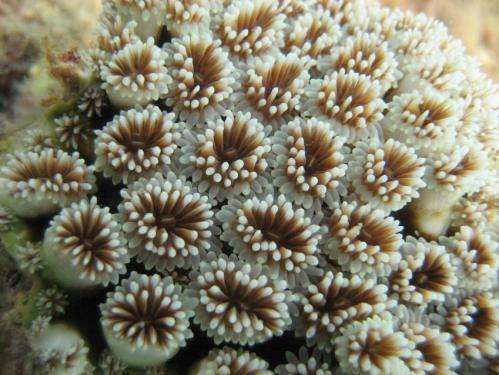Close up of polyps are arrayed on a coral, waving their tentacles. There can be thousands of polyps on a single coral branch. Credit: Wikipedia
Habitats under different levels of protection host marked / contrasted different communities of plants, birds and fish, despite having similar numbers of species, according to a study publishing 19th May, 2021 in the open-access journal PLOS Biology. The research, led by Nicolas Loiseau at the CNRS and University of Montpellier, highlights the importance of diverse conservation strategies to maximize regional biodiversity and maintain ecosystem services.
The researchers analyzed data from published surveys of Indo-Pacific coral reef fish, French alpine plants, and North American birds—totaling more than 5,500 species—observed in 655 protected areas and adjacent unprotected sites. They found distinct groups of species in "Strictly Protected' areas (where human activities are limited and carefully controlled), compared to "Restricted' areas (where some managed human activity is allowed) and "Non-protected' sites. Sites under different levels of protection were home to a similar number of species, but the composition of species was significantly different when controlling for environmental conditions, sampling effort, and species rarity.
The plants, birds and fish living in non-protected areas were not merely a subset of those found in protected areas—instead, each type of protection favored particular species. For example, between 12 and 15 percent of species were found exclusively in non-protected areas, indicating that many species can tolerate and even thrive in human-disturbed habitats. However, for species categorized by the IUCN Red List as Critically Endangered, Endangered, Vulnerable or Near Threatened, 58 percent of fish, 11 percent of birds and 7 percent of plants were confined to locations with the strictest conservation protections.
Studies aiming to evaluate the effect of conservation protections need to measure both species richness and composition to get a comprehensive view, the authors say. They suggest that reinforcing Strictly Protected areas with Restricted areas nearby may create a mosaic of protection levels maximizing the number of species at the regional scale, an important outcome for sustaining ecosystems and their services.
Dr. Loiseau notes: " Protected areas are the flagship management tools to secure biodiversity from deleterious human activities. Our study conveys message highlighting novel opportunities to evaluate effect of protected areas and inform conservation governance."
"Increase the size and the number of strictly protected areas will boost the conservation of endangered species."
"Future investigation on species identities and functions would reveal mechanisms underlying the important dissimilarity between communities under different protection levels."
More information: Loiseau N, Thuiller W, Stuart-Smith RD, Devictor V, Edgar GJ, Velez L, et al. (2021) Maximizing regional biodiversity requires a mosaic of protection levels. PLoS Biol 19(5): e3001195. doi.org/10.1371/journal.pbio.3001195
Journal information: PLoS Biology
Provided by Public Library of Science
























